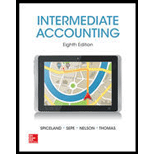
(1)
Bonds
Bonds are a kind of interest bearing notes payable, usually issued by companies, universities and governmental organizations. It is a debt instrument used for the purpose of raising fund of the corporations or governmental agencies. If selling price of the bond is equal to its face value, it is called as par on bond. If selling price of the bond is lesser than the face value, it is known as discount on bond. If selling price of the bond is greater than the face value, it is known as premium on bond.
Straight-line amortization bond
Effective interest rate of amortization bond
Effective interest rate method of amortization is a process of amortizing premium on bond or discount on bond, which allocates the different amount of interest expense in each period of interest payment, but at a constant percentage rate.
To Prepare: The amortization schedule to determine the interest expenses at the effective interest rates.
(2)
To Prepare: The amortization schedule to determine the interest expenses at straight line method.
(3)
To Prepare: The
(4)
To Explain: The pattern of interest differs between the two methods.
(5)
The price value of the bonds as on 30th June 2018 for $10,000 of the
bonds.
Want to see the full answer?
Check out a sample textbook solution
Chapter 14 Solutions
INTERMEDIATE ACCOUNTING
- I am looking for the correct answer to this general accounting question with appropriate explanations.arrow_forwardI need help with this general accounting question using the proper accounting approach.arrow_forwardThe company produced 6,200 units in May using 15,900 liters of direct material and 3,400 direct labor hours.arrow_forward
- Given solution for General accounting question not use aiarrow_forwardCosmic Technologies is evaluating a project that costs $2,500 and has no salvage value after 4 years. The project will produce a gadget that will sell for $155 per unit and incur variable costs of $120 per unit. The company has fixed costs of $4,200 and requires a 13% return on its projects. If Cosmic sells 240 units, what is the firm's degree of operating leverage?arrow_forwardPlease explain the solution to this general accounting problem with accurate explanations.arrow_forward

 AccountingAccountingISBN:9781337272094Author:WARREN, Carl S., Reeve, James M., Duchac, Jonathan E.Publisher:Cengage Learning,
AccountingAccountingISBN:9781337272094Author:WARREN, Carl S., Reeve, James M., Duchac, Jonathan E.Publisher:Cengage Learning, Accounting Information SystemsAccountingISBN:9781337619202Author:Hall, James A.Publisher:Cengage Learning,
Accounting Information SystemsAccountingISBN:9781337619202Author:Hall, James A.Publisher:Cengage Learning, Horngren's Cost Accounting: A Managerial Emphasis...AccountingISBN:9780134475585Author:Srikant M. Datar, Madhav V. RajanPublisher:PEARSON
Horngren's Cost Accounting: A Managerial Emphasis...AccountingISBN:9780134475585Author:Srikant M. Datar, Madhav V. RajanPublisher:PEARSON Intermediate AccountingAccountingISBN:9781259722660Author:J. David Spiceland, Mark W. Nelson, Wayne M ThomasPublisher:McGraw-Hill Education
Intermediate AccountingAccountingISBN:9781259722660Author:J. David Spiceland, Mark W. Nelson, Wayne M ThomasPublisher:McGraw-Hill Education Financial and Managerial AccountingAccountingISBN:9781259726705Author:John J Wild, Ken W. Shaw, Barbara Chiappetta Fundamental Accounting PrinciplesPublisher:McGraw-Hill Education
Financial and Managerial AccountingAccountingISBN:9781259726705Author:John J Wild, Ken W. Shaw, Barbara Chiappetta Fundamental Accounting PrinciplesPublisher:McGraw-Hill Education





